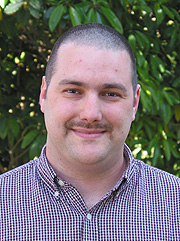|
April 19, 2004
Physics student finds serious fun at SCIPP labs
By Tim Stephens
For physics major John Wray, the best part of the learning process
is when he can apply his knowledge to solve a practical problem. He
especially enjoys the satisfaction that comes from building something--a
piece of equipment or an experimental apparatus--and seeing that it
works.
|

John Wray is involved in a Santa Cruz Institute for Particle Physics
outreach program that uses an electrifying demonstration of Tesla
coil physics. Photo: Tim Stephens
|
| Profiles of
other outstanding UCSC students are available online. |
The Santa Cruz Institute for Particle Physics (SCIPP) at UCSC has
given Wray plenty of opportunities to get that kind of satisfaction.
His contributions at SCIPP include working on major research projects
and helping with the institute's outreach programs in the local schools.
As a junior transfer student from Cabrillo College, Wray had heard
that UCSC offers opportunities for undergraduates to work in research
labs, and he didn't waste any time seeking them out. He started working
in the SCIPP laboratories with Hartmut Sadrozinski, adjunct professor
of physics, shortly after he arrived on campus in 2002.
"I just kept asking for things to work on, and Hartmut kept giving
me projects, and now it seems like a never-ending supply of things to
do," Wray said.
One of the first things Wray got involved in was a SCIPP outreach
program that uses an electrifying demonstration of Tesla coil physics
to show middle school and high school students that science can be fun
and exciting. A Tesla coil takes the output from an ordinary electrical
outlet and steps it up to extremely high voltages to produce crackling
electric arcs and other spectacular displays of electricity. The riveting
spectacle serves up vivid demonstrations of basic principles of electricity.
(See earlier Currents story at http://www.ucsc.edu/currents/00-01/10-30/tesla.html.)
"It's the coolest thing. I really enjoy seeing the looks on the
faces of the students when they see these three-foot arcs of electricity,"
Wray said. "It gets them excited about science, because they see
that it's something you can have fun with."
But Wray soon noticed that some of the equipment used in the demonstrations
was showing signs of wear and tear. He completely rebuilt the "suit
of armor" that plays a central role in the demonstrations, and
built other key pieces of equipment for the program.
"John has been a real mainstay of our Tesla coil program,"
Sadrozinski said.
Wray has also worked on a variety of SCIPP research projects. The institute
is recognized internationally as a leader in the development of silicon-based
sensors and custom electronics for state-of-the-art particle detectors.
SCIPP's detectors are used to track subatomic particles in high-energy
physics experiments around the world, and will even be used in a space-based
telescope. SCIPP researchers are also involved in developing biomedical
applications of these technologies.
"I never imagined that I'd get to work on the kinds of projects
I've been doing," Wray said. "I don't understand why everyone
isn't doing this. I think a lot of students just don't realize the opportunities
there are to get involved in interesting research."
One of Wray's projects, which he started last summer and is finishing
up now, involved testing components for the Gamma-ray Large Area Space
Telescope (GLAST), which NASA plans to launch into orbit in 2007. SCIPP
researchers are working on the design and fabrication of the GLAST instruments.
Wray has also been working with Sadrozinski on the evaluation of detectors
for a Particle-Tracking Silicon Microscope, a collaboration with medical
researchers at Loma Linda University Medical Center to develop biomedical
applications of proton beams.
In order to measure the particle-counting efficiencies of the detectors,
Wray ended up taking a machine-shop course and building a custom-made
apparatus for doing the tests.
"I enjoy building things. Learning out of books is fine, but it
is so much more interesting when you can use your hands and put theory
into practice," he said.
Wray has managed to balance his work at SCIPP with a full course load
and an equally full home life. He has a one-year-old son, who sometimes
accompanies him to Tesla coil demonstrations. In addition, he and his
wife care for a woman with Down's syndrome who has been living with
them for the past six years.
"She's a real character--I fell in love with her the first time
I met her. So that's one more ingredient in the mix, and somehow it
all works out," Wray said.
Sadrozinksi said he is impressed by Wray's dedication and commitment
to becoming a physicist. Wray will finish up his course work this year
and then focus on his senior thesis. After that, he plans to go on to
graduate school.
An Undergraduate Research Fellowship from Crown College has supported
Wray's work on the Particle-Tracking Silicon Microscope project, which
he will present at the campus Undergraduate Research Symposium in June.
While many students might consider that project good enough for a senior
thesis, Wray has bigger ambitions.
"That's been a lot of fun, sort of a practice project for the
senior thesis," he said. "I want do a really good senior thesis."
Profiles of other outstanding UCSC students are available online.
Return to Front Page
|